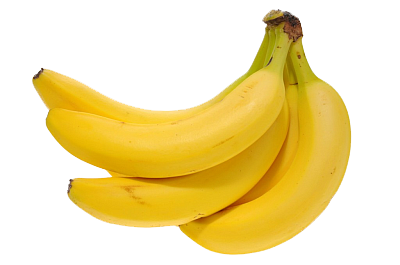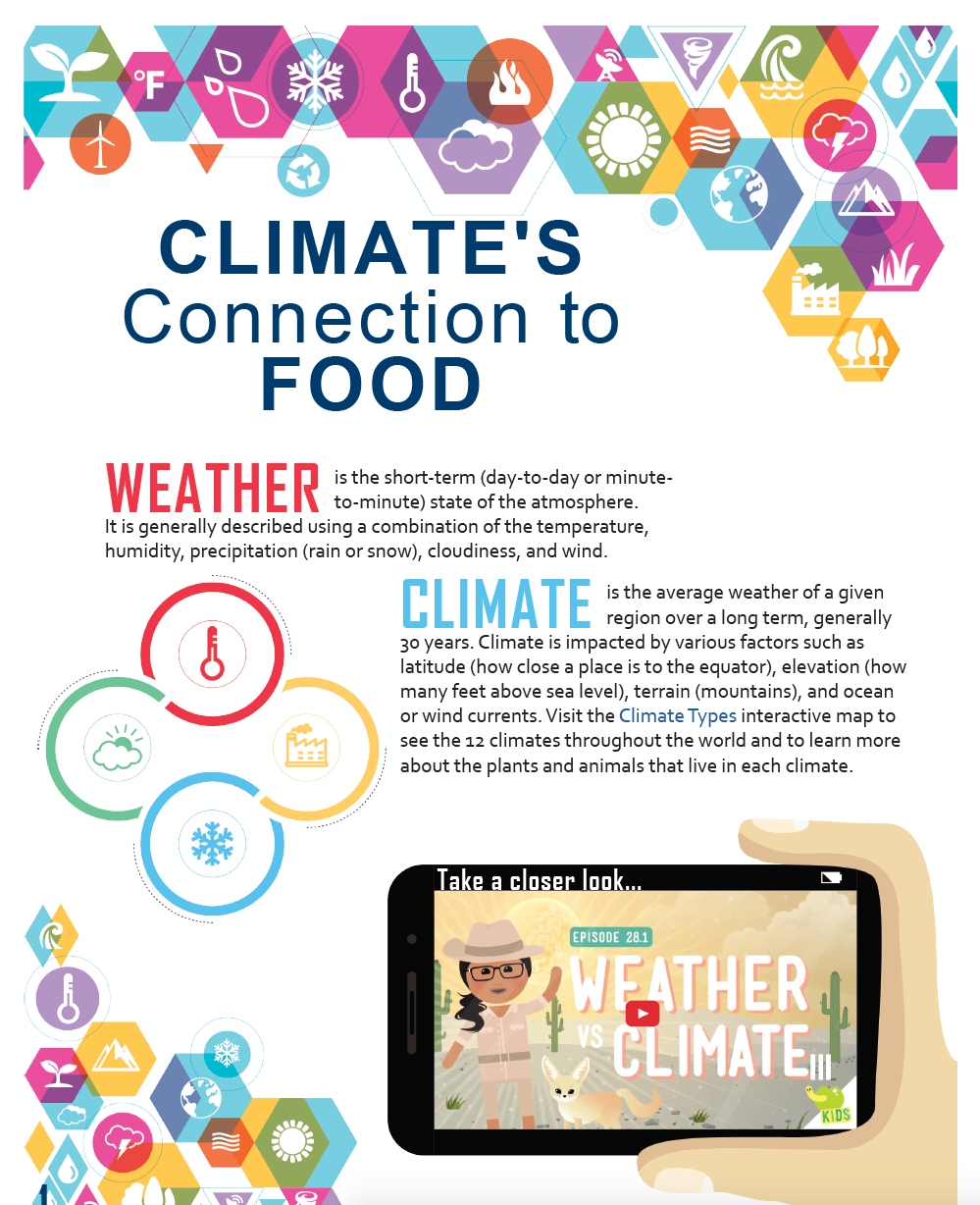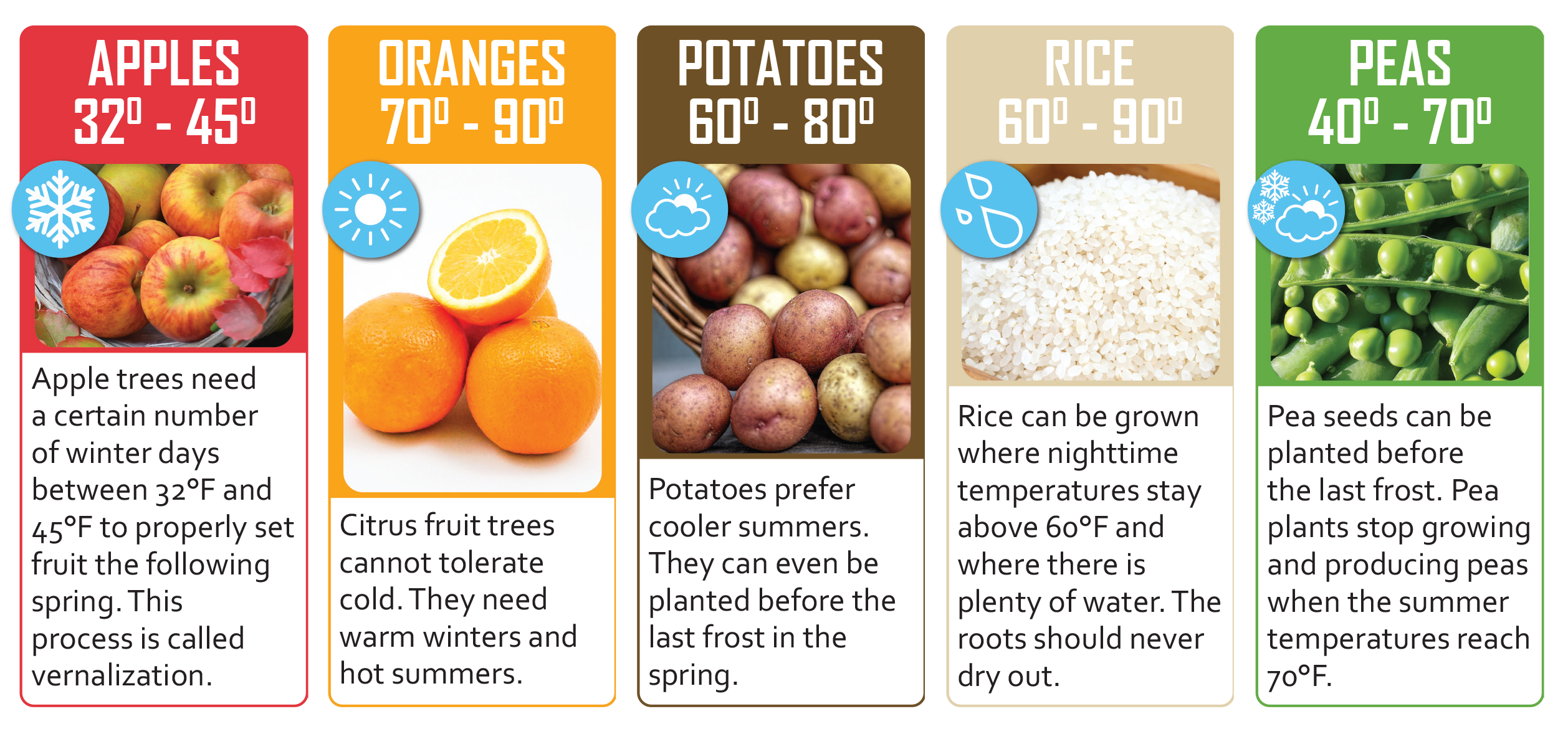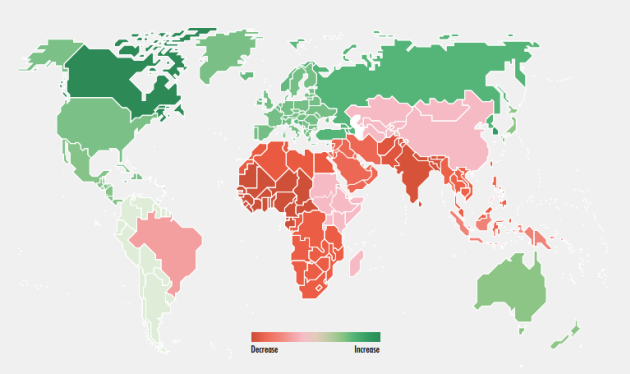Curriculum Matrix
Lesson Plan
Where Does it Grow? The Science of Climate and Food
Grade Level
Purpose
Students will discover the connection between climate and our food supply as they answer the question, "Where does it grow?" They will also explore the consequences of climate change on our food supply and discover how advances in science can help farmers adapt to climate change. Grades 9-12
Estimated Time
Materials Needed
Engage:
- Climate Change Phenomena PowerPoint
Activity 1: Where Does it Grow?
- Where Does it Grow? cards, 1 copy per class, cut into individual cards
- World Map to project on board or a World Fabric Map
Activity 2: What is Climate? Climate's Connection to Food
- Weather vs. Climate video
- Climate's Connection to Food handout, digital access or 1 copy per student
- Major U.S. Climate Zones map
Activity 3: Food and Climate Change
Vocabulary
adaptation: a change or the process of change by which an organism or species becomes better suited to its environment
agricultural practices: a collection of principles used to facilitate farming
climate: the prevailing weather conditions in a specific area over a long period of time
climate change: a change in global or regional climate patterns which can include increased temperatures and extreme weather events such as droughts, floods, etc.
deforestation: the action of clearing a wide area of trees
food security: the state of having reliable access to a sufficient quantity of affordable, nutritious food
fossil fuel: a natural fuel such as coal or petroleum formed in the geological past from the remains of living organisms
global warming: a gradual increase in the overall temperature of the Earth's atmosphere generally attributed to the greenhouse effect caused by increased levels of carbon dioxide and other pollutants
growing season: the part of the year during which rainfall and temperature allow plants to grow
mitigation: the act of reducing the severity of something
temperate: a region or climate characterized by mild temperatures
tropical: a non-arid climate in which all twelve months have mean temperatures warmer than 18° C
weather: the state of the atmosphere at a given place and time in regards to heat, dryness, sunshine, wind, rain, etc.
Did You Know?
- In the United States, food is shipped an average of 1,500 miles before being sold.1
- Food travels from farm to grocery store in trucks, trains, airplanes, cargo ships, and barges.
- There are five major climates in the United States.2
Background Agricultural Connections
Most Americans have access to a wide variety of fruits, vegetables, grains, nuts, dairy, and meat products. Each food item may have been produced on a nearby farm, in a neighboring state, from somewhere across the country, or from overseas locations. Foods are grown in precise locations due to their climate and growing conditions.
Weather is the short-term (day-to-day or minute-to-minute) state of the atmosphere. It is generally described using a combination of temperature, humidity, precipitation, cloudiness, and wind conditions. Climate is the average weather of a given region over a long term, generally 30 years. Climate plays a large role in the production of plant-based foods. Every plant has its own climate requirement for productive growth. For example, citrus fruits such as oranges, grapefruit, lemons, and limes require a tropical or subtropical climate. In the United States citrus fruits are grown primarily in Florida and Southern California. Tropical fruits such as pineapple, mangos, passion fruit, and papaya can only be grown in Hawaii or in other tropical climates. Berries and fruits such as strawberries, raspberries, peaches, and melons can be grown in more temperate climates as long as the length of the growing season is sufficient for the plants to produce their fruit. Other crops prefer cooler climates such as wheat, potatoes, sugar beets, and many vegetables such as broccoli, onions, lettuce, carrots, and spinach.
Climate Change and global warming can often be confused or used interchangeably, but global warming refers only to the long-term warming of the planet since the early 20th century.3 Looking at the big picture, trends of warming on the earth's surface are not new. See How the World Warmed: Climate Change through History for more information. Climate change refers to a broad range of phenomena such as increased temperature trends, sea levels rising, and extreme weather events such as heat waves, drought, storm surges, flooding, etc.3
Climate change is attributed largely to increased levels of atmospheric carbon dioxide that is produced by the use of fossil fuels, deforestation, and agricultural practices. Climate change can impact the health and productivity of crops, livestock, fish, and forests. Therefore, climate change has the potential to threaten our food security. Food security is defined by the FAO as a state when all people, at all times, have physical and economic access to sufficient, safe, and nutritious food to meet their dietary needs and food preferences for an active and healthy life.4
Agriculture is impacted by climate change in a number of ways. Changes in average temperatures, rainfall, climate extremes, and changes in pests and diseases are a few examples. Agriculture is also known to contribute to climate change due to the greenhouse gasses that are emitted in agricultural processes as well as conversion of non-agricultural land into agricultural land.5
Looking forward, questions can be investigated such as How can we reduce greenhouse gas emissions? or How can agriculture adapt to a changing climate? Answers to these questions lie in both adaptations and mitigation. Mitigations refer to the steps we take to slow down the rate of climate change by reducing greenhouse gases in our atmosphere. Adaptations are actions we can take to prepare for the impacts of climate change. Examples could include selecting varieties of crops better suited to warmer weather patterns, increasing storm drainage in cities to prepare for flooding, or planting trees along streams and rivers to provide more shade and cooler water temperatures for cold water trout streams.
Engage
- Project the Climate Change Phenomena PowerPoint.
- Inform students that you will be showing them a series of maps. Each map represents the farms where one food crop is grown in the United States. As you progress through the maps (slides 3-8), see if students can identify the crop based only on the location of the farms. Encourage students to ask questions and watch for patterns and correlations.
- After viewing the maps, ask, "Are all crops grown in all 50 states?" (No) "Why?" (slide 9) Allow students time to think and then discuss their answers as a class. Guide the discussion to the topics of weather and climate. Help students recognize that each of these plants require their own specific climate and weather conditions to grow.
- Ask students, "Where are bananas grown?" (slide 10) After viewing the map (slide 11) explain that bananas grow in tropical climates where it is warm and humid.
- Pose the question, "Could bananas ever be grown in America's breadbasket?" (slide 12) Explain to students that they will be exploring the relationships of weather, climate, climate change, and the production of our food.

Explore and Explain
Activity 1: Where Does it Grow?
Preparation:
On the day prior to class, give each student one Where Does it Grow? card. Try to distribute all of the cards, doubling up if needed. Assign students a homework activity to visit the produce section of their local grocery store to discover the location where their assigned fruit or vegetable was grown. Give students the following tips to help them succeed:
- If it was grown outside of the United States, it will have a sticker or label indicating the country it was produced in.
- Packaged produce (like baby carrots or bags of apples) often lists the name and city/state of the farm where it was grown.
- Loose produce, if it was grown in the United States, doesn’t always have an individual label indicating its origin. They can ask a produce worker to check the shipment boxes, which often have the name and location of the farm.
- If students exhaust the options above and cannot find an origin of their assigned fruit or vegetable, they should do a Google search and list the top 3 states (or countries) where it is grown.
Procedure:
- At the beginning of class, project a map of the world on the board. Place a star on the map indicating "you are here."
- Instruct students to tape their fruit/vegetable card to the board on the state or country where it was produced. Remind students that most if not all of these food items are available at a grocery store nearby. As you review the map, ask questions such as:
- Which foods are grown closest to us?
- Which foods have been grown the farthest away?
- Are there any foods that are currently out of season for where we live? If so, are there any commonalities regarding the origin of out-of-season fruits and vegetables?
- Are there any foods that we do not grow in the United States?
- Note to Teacher: Sometimes when certain fruits and vegetables are out of season in one growing region, they are in season in another growing region that may be closer to or on the other side of the equator. Depending on the time of year and your climate, this pattern may be observed during this activity
- Ask, "Why do you think each of these foods were grown in these specific places and then shipped here?" Allow students to brainstorm answers using their prior knowledge. If needed, provide guiding questions:
- Why are oranges (or another tropical fruit) grown in subtropical or tropical locations instead of [Colorado] or [Nebraska]? (Climate. Citrus fruits do not tolerate cold temperatures.)
- Why aren't bananas grown in the United States? (Climates in the United States are not ideal for bananas. Most bananas we eat are grown in Latin America.)
- Could any food crop be grown in any location across the United States? Why or why not?
- Teacher Tip: Additional guiding questions will be dependent on the current season and where you live.
- After your class discussion, have students summarize the answer to the question (in step 3) into a few words. (Students will likely identify weather or climate.)
| Climate is only one factor that determines where food is grown. This lesson focuses on the science of climate and food. Many more factors such as economics, technology, government regulations, available space, and available workers also impact where food is produced. For a cross-curricular lesson, explore the question "Where does it grow?" in a scope beyond science. |
Activity 2: What is Climate? Climate's Connection to Food
- Ask students to define and compare the words weather and climate. Then, show the video, Weather vs. Climate.
- Brainstorm and list on the board geographical factors or conditions that contribute to a climate in a given area.
- Temperature:
- Higher elevations typically have colder climates and shorter growing seasons. Lower elevations are often warmer.
- Latitude, or distance from the equator and location on the North or South of the equator impacts temperature, duration of seasons, and the time of year for each season.
- The yearly average temperature is important, but the range (lowest to highest temperature) is critical to plant growth. Even just a few days of extra cold temperatures can freeze and destroy a crop.
- Precipitation:
- The annual amount of rain and/or snowfall. Arid climates limit plant growth.
- Irrigation can increase ability to grow crops in specific areas if water can be collected in reservoirs (usually from winter snow pack) and then used throughout the dry summer.
- Temperature:
- Give each student one copy of the Climate's Connection to Food handout and instruct them to read it. Write the following question on the board, "How is climate connected to our food supply?" Inform students to be prepared to answer the question after they complete the reading.

- Have a post-reading class discussion about the connection of food and climate. Conclude that farms are established in locations where the climate is conducive to plant growth needs. Food transportation by truck, plane, train, or cargo ship allows foods to travel a long distance from farm to consumer.
- Ask, "How would our diets differ if we didn't transport food from one climate to another?" (Some climates would be very limited in the variety of foods they could eat. Other climates would be less restricted, but would likely see a difference in variety and year-round availability.)
- Project the Major U.S. Climate Zones map and review the climate zones. Gather the "Where does it grow?" cards (of the foods that were grown in the United States) and place them on the climate map to see what climate they were grown in.
| A relatively small number of foods available at your grocery store might have been grown in a greenhouse. Keep this in mind if one of your students has a food that originated from a colder climate. Greenhouses use technology to artificially create a climate adequate for plant growth. This allows more foods to be grown in climates that are naturally too cold for plant growth. |

Activity 3: Food and Climate Change
- Return to the question posed in the Engagement portion of the lesson. Ask students, "Could bananas ever be grown in America's breadbasket?" Have a class discussion prompting students to reflect on what they have learned.
- With a basic knowledge of the connection of climate and food production, ask the following questions:
- Does climate change impact our food supply?
- Would climate change impact farms around the world equally?
- Would climate change be all negative in every region of the world?
- Project the Food and Agriculture of the United Nation's map on the board. Explain that this map uses 2050 as an end point and estimates which countries in the world will likely see a decrease in food production due to climate change and which would see an increase in food production as a result of climate change.

- Show the video Climate, Agriculture and the Challenges Ahead.
- After the video, explain that there are two ways we can act in the face of climate change. First, we can mitigate climate change by making more climate-smart choices to decrease our greenhouse gas emissions. We can also try to adapt to a changing climate.
- As an example, show Climate Smart Farming Story: Adaptation and Agriculture. Begin at 0:34 and stop the video at 2:24.
- Use the following questions to check for comprehension and discuss the video:
- Why is frost damage a concern in climate change if the winters are getting warmer? (Temperatures induce apple trees to come out of winter dormancy and bloom. Warmer winter temperatures can induce temperatures too soon, leaving the apple tree at severe risk of frost damage. When apple blossoms freeze, they will not produce apples.)
- What can apple growers do to adapt to a changing climate? (They can use technologies such as misting systems, wind machines, and advanced weather alert systems to avoid or minimize frost damage. They can also rely on plant breeders to develop varieties of apple trees with later seasonal bloom times.)
Elaborate
-
Explore True Food TV's "How Does it Grow?" series. Assign students to make note the location of the farms and make connections about the climate required to grow the crop.
-
Assign students an activity to help them discover the climate of your state and what natural resources you have to support the production of food. Visit the State Agricultural Facts webpage. Click on your state to find more information and to customize this activity to your state's agricultural resources.
Choose from the following ideas:
- Develop a marketing campaign to promote one of your state's top commodities.
- Create a state agriculture map with pictures of the top commodities grown/raised in your state. Explore your state's Ag Facts, State Agriculture in the Classroom program resources, and your states Department of Agriculture website to obtain information.
- Complete the Culinary Concepts Problem-based Learning (PBL) activity.
- Create a commercial or video to promote one of your state's top commodities.
- Interview a marketing expert from your state's department of agriculture to talk about the impact of what is grown/raised and sold from your state.
-
This lesson highlights research in agriculture that can be done to adapt to climate change. See the lesson, The Carbon Cycle and Climate Smart Agriculture to discuss mitigations in agricultural practices that can decrease greenhouse gas emissions.
-
Visit the Interactive Map website and view numerous agricultural and geographical maps of the United States. Have students discover what commodities your state produces and where they rank nationally. Then help them correlate geography with the production of food. Explore questions such as:
- Where are carrots grown in the United States?
- What climates in the United States are suitable for growing citrus fruits?
- What states produce the most eggs?
- How many growing degree days are there in my state/county?
- ...and more!
Evaluate
After conducting these activities, review and summarize the following key points:
- Climate and natural resources determine the type of crops that can be grown in a particular area.
- Every food crop has its own unique requirements for growth including climate, soil type, water, etc.
- The ability to transport food long distances (by truck, train, plane, or cargo ship) allows our diets to include a variety of foods that are available year-round.
- Climate change impacts our food supply. The application of science can help agriculture adapt to changing climates and conditions.
Sources
- http://www.foodsystemprimer.org/food-distribution/
- https://utah.pbslearningmedia.org/resource/buac17-35-sci-ess-usclimatezones/major-us-climate-zones/#.Xllh6pNKja4
- https://climate.nasa.gov/
- https://www.futurelearn.com/courses/climate-smart-agriculture/0/steps/26565
- https://en.m.wikipedia.org/wiki/Climate_change_and_agriculture
Recommended Companion Resources
Author
Organization
| We welcome your feedback! If you have a question about this lesson or would like to report a broken link, please send us an email at matrixelearning@gmail.com. If you have used this lesson and are willing to share your experience, we will provide you with a coupon code for 10% off your next purchase at AgClassroomStore. |
